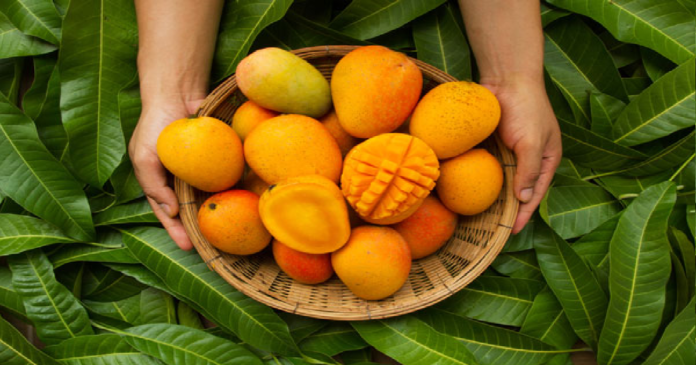The Indian mango, revered globally for its rich taste and versatility, boasts a plethora of varieties that cater to diverse palates. From the famed Alphonso to the lesser-known Totapuri, each variety brings its unique flavor profile to the table, enticing mango enthusiasts across the country.
Among the most sought-after varieties is the Alphonso, also known as Hapus or Badami. Renowned for its sweet, aromatic flesh and buttery texture, the Alphonso holds the title of the “King of Mangoes” and commands a premium in the market. Its distinct flavor and vibrant yellow-orange hue make it a favorite among mango connoisseurs.
Another popular variety is the Kesar mango, prized for its intense sweetness and saffron-like aroma. Cultivated primarily in the state of Gujarat, the Kesar mango boasts a rich, creamy texture and a golden-yellow flesh that melts in the mouth, leaving behind a lingering sweetness.
Hailing from West Bengal, the Himsagar mango is celebrated for its juicy, fiberless flesh and tropical aroma. With its exceptionally sweet taste and smooth texture, the Himsagar mango is a favorite choice for fresh consumption and dessert preparations.
In the northern region of India, the Daseri mango reigns supreme. Characterized by its small size and vibrant yellow skin, the Daseri mango is prized for its sweet, tangy flavor and firm, fiberless flesh. It is often enjoyed as a refreshing snack or used in salads and chutneys.
Among the lesser-known varieties is the Totapuri mango, which is popular in South India for its tangy flavor and elongated shape. Despite its slightly sour taste, the Totapuri mango is prized for its versatility and is commonly used in pickles, jams, and beverages.
The Government of India, recognizing the significance of mangoes in Indian culture and cuisine, promotes the cultivation and consumption of diverse mango varieties through various initiatives. By celebrating the rich diversity of mangoes, the government aims to highlight the country’s agricultural prowess and promote the consumption of nutritious, locally-grown fruits.
As mango season approaches, enthusiasts eagerly anticipate the arrival of their favorite varieties, eager to savor the unique flavors and aromas that each mango brings to the table. Whether enjoyed fresh or incorporated into delectable dishes, Indian mangoes continue to captivate taste buds and hold a special place in the hearts of millions across the country.
As mango season unfolds across India, enthusiasts and farmers alike revel in the abundance of this tropical delight. Beyond the popular varieties like Alphonso, Kesar, Himsagar, Daseri, and Totapuri, there exists a treasure trove of lesser-known mango cultivars that showcase the country’s rich agricultural heritage.
One such variety is the Langra mango, originating from the northern state of Uttar Pradesh. Named after a lame farmer who first cultivated it, the Langra mango is distinguished by its greenish-yellow skin and fibrous, juicy flesh. Despite its rustic appearance, the Langra mango boasts a unique flavor profile characterized by its sweet, tangy taste with hints of citrus.
In the southern state of Karnataka, the Neelam mango reigns supreme. Known for its vibrant orange-yellow skin and firm, fiberless flesh, the Neelam mango is prized for its sweet, aromatic flavor and refreshing juiciness. It is often enjoyed fresh or used in culinary preparations such as smoothies, salads, and desserts.
Moving eastward to the state of Bihar, the Mallika mango takes center stage. A hybrid of the Neelam and Dasheri varieties, the Mallika mango combines the best of both worlds, boasting a sweet, tropical flavor and smooth, fiberless texture. Its compact size and vibrant color make it a popular choice among mango enthusiasts.
Further down south in Tamil Nadu, the Banganapalli mango holds sway. Believed to have originated in the town of Banganapalle in Andhra Pradesh, this mango variety is renowned for its large size, thin skin, and sweet, aromatic flesh. It is often referred to as the “King of Mangoes” in South India and is highly prized for its exquisite flavor and texture.
In addition to its culinary allure, the mango holds significant cultural and religious significance in India. It is often associated with festivals such as Holi and Vishu, where it is offered as a symbol of prosperity and abundance. Mango motifs adorn traditional artwork, textiles, and jewelry, serving as a testament to its enduring legacy in Indian culture.
As India continues to celebrate its rich diversity of mango varieties, efforts are underway to promote sustainable farming practices and preserve heirloom cultivars. Initiatives such as organic farming, agroforestry, and genetic conservation aim to safeguard the future of these beloved fruits while ensuring their availability for generations to come.

